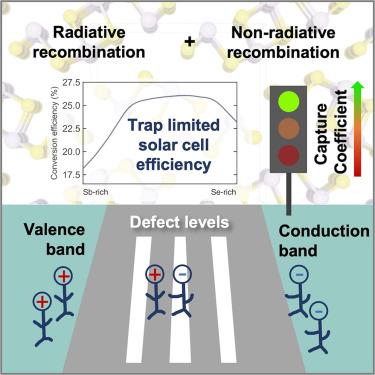Joule ( IF 38.6 ) Pub Date : 2024-06-03 , DOI: 10.1016/j.joule.2024.05.004 Xinwei Wang , Seán R. Kavanagh , David O. Scanlon , Aron Walsh

|
Antimony selenide () is at the forefront of an emerging class of sustainable photovoltaic materials. Despite notable developments over the past decade, the light-to-electricity conversion efficiency of has reached a plateau of 10%. Is this an intrinsic limitation of the material, or is there scope to rival the success of metal halide perovskite solar cells? Here, we assess the trap-limited conversion efficiency of . First-principles analysis of the hole and electron capture rates for point defects in the bulk material demonstrates the critical role of vacancies as active recombination centers. We predict an upper limit of 26% efficiency in grown under optimal equilibrium conditions where the concentrations of charged vacancies are minimized. We further reveal how the detrimental effect of Se vacancies can be reduced by extrinsic oxygen passivation, highlighting a pathway to achieve high-performance metal selenide solar cells close to the single-junction thermodynamic limit.
中文翻译:

Sb2Se3 太阳能电池的效率上限
硒化锑 ( ) 处于新兴可持续光伏材料的前沿。尽管在过去十年中取得了显着的发展, 的光电转换效率已达到 10% 的稳定水平。这是该材料的固有局限性,还是有可以与金属卤化物钙钛矿太阳能电池相媲美的成功空间?在这里,我们评估了 的陷阱限制转换效率。对块体材料中点缺陷的空穴和电子捕获率的第一性原理分析证明了空位作为活性复合中心的关键作用。我们预测在带电空位浓度最小化的最佳平衡条件下生长的 效率上限为 26%。我们进一步揭示了如何通过外在氧钝化来减少硒空位的有害影响,强调了实现接近单结热力学极限的高性能金属硒化物太阳能电池的途径。











































 京公网安备 11010802027423号
京公网安备 11010802027423号